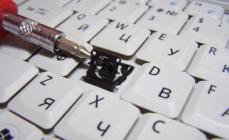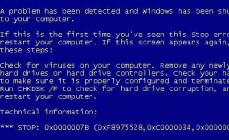Guide to removing write protection from a USB flash drive.
Navigation
USB flash drives and microSD memory cards are widely used for temporary storage of data. The files stored on them are easy to delete, but they often leave behind a lot of invisible garbage, which clogs the memory and slows down the reading of information on the USB drive. To deep clean memory, users resort to formatting flash drives. But quite often, while formatting a flash drive, a notification pops up informing you that it is write-protected.
In our article we will try to figure out how to bypass the protection of a locked flash drive or memory card.
A similar message about disk security can pop up for various reasons, and not only when trying to format a flash drive. It happens that a USB drive has served you faithfully for a long time, but one fine day, when you try to transfer files to it or, conversely, take them from it, such a notification appears. Let's look at the main reasons why such a nuisance can happen:
Physical blocking

- Many USB flash drives and memory cards have a small fuse on their case. It is a standard slider switch that is easy to miss. If you move the switch to a certain position, it will act as a fuse and will not allow you to accidentally delete data from the flash drive. Carefully inspect the body of the flash drive for the presence of a switch slider. If there is one, move it to a different position and try to repeat the procedure for deleting files from the USB drive.
New flash drive

- If you purchased a new USB flash drive or microSD card, and while writing files to it you receive a message about the security of the disk, then it is most likely that your device was previously formatted in an ancient file system FAT32. To restore order in the file system, it will need to be formatted in the format NTFS. We'll talk about this a little later.
- Another possible reason for this error to occur when using a new flash drive is a virus. Before you, the store clerks where you bought the flash drive could have used the drive and placed a malicious program on it. Just in case, scan your computer and flash drive for viruses with any available antivirus program.
Physical damage

- Quite often the reason for the notification is “ The disc is write protected» is associated with physical damage to the drive. Perhaps, due to a strong impact of the device on the floor, the contact fell off or microcracks appeared. The worst case scenario is damage to the memory chip from impact or natural wear and tear. If, in the case of a fallen contact, you can recover data from a flash drive using special equipment, then if the chip is damaged, you can say goodbye to it.
How to format a write-protected flash drive using standard Windows operating system tools?
Before resorting to using third-party software, you should try to break the write protection using Windows tricks. Do the following one by one:
- Step 1. Expand menu " StartExecute" In the window that opens, enter “ cmd" and press " Enter" to activate the command line.

- Step 2. In the window that opens, you will need to write the command “ diskpart" and press " Enter» to start a service that works with computer disks.

- Step 3. A new window will open where you will need to write the command “ list disk" and press " Enter» to display existing hard drive partitions and USB drives. Your flash drive must first be connected to the computer.

- Step 4. A list of hard drive partitions and connected storage devices will appear on the monitor, each of which is assigned its own number. In the same window, write the command “ select disk H", where instead of " H“You need to put the number under which your flash drive is located. Click " Enter».

- Step 5. Once the flash drive is selected, enter the command " attributes disk clear readonly» to clear its attributes. Remember that all files from it will be erased. Click " Enter».
- Step 6. Next, enter the command “ clean" and press " Enter» to clean up the disk.
- Step 7. Since the flash drive has a file system format FAT32, we need to reformat it into the format NTFS. To do this, write the command “ format fs=ntfs" and press " Enter».
- Step 8. The flash drive is formatted and now all that remains is to assign it a letter under which it will be displayed on the computer. To do this, write the command “ assign letter=K" and press " Enter" Instead of " K»You can set any other letter.
If this procedure does not lead to a positive result, then there is a possibility that the USB flash drive has a slightly different write protection system, which can be removed through the Group Policy Editor. To do this, do the following:
- Step 1. Expand menu " Start" and left-click on the item " Execute" In the window that opens, write “ gpedit.msc" and press " Enter».

- Step 2. In the window that opens, go to “ Computer configuration", then " Administrative Templates", then " System" and further in " Access to removable storage devices" In the window on the right, find the line “ Removable drives: Disable write"and look carefully at her condition. If recording prohibition is activated, double-click on the line to bring up the menu and set the status to “ Disabled" To finish, click the " OK».

- Unfortunately, standard Windows tools cannot always solve this problem. Sometimes you have to resort to third-party utilities designed to recover and format USB drives. It is best to use the utilities, the disk with which is sold complete with the flash drive. But if you don’t have it, you can use the program HUDS Format Tool which is possible.

- To format a flash drive using this program, connect the flash drive to your computer, download and run the program. In the window that opens, select your device from the list, set the file system format " NTFS", check the box next to the line " Quick formatting" and click the " Begin" After completing the formatting process, the flash drive should again be usable.
- If none of the above methods helped you, then most likely the problem lies in physical damage to the device and the only way out of this situation is to purchase a new USB flash drive or memory card.
VIDEO: How to remove write protection from a flash drive?
SD cards can be found in cameras and old phones. These memory cards can be write-protected - that is, they cannot be formatted just like that, only after installing certain utilities.
SD cards are connected to the computer via an adapter. Typically there will be a switch labeled Lock - circled in red in the picture below.
Make sure the lock is in the open position and the card is not mechanically blocked. Perhaps simply toggling this slider can remove the lock without you having to do it programmatically. If the card is still write-protected, then you need to turn to Windows utilities.
Unlocking a flash drive via diskpart
One of the easiest ways is to use the console utility diskpart, which is used to manage connected disks. It can be called via the command line.

- Open the Start menu (Windows 7) or go to the search bar from the taskbar (Windows 10). Type "cmd" and open a command prompt.
- Enter the command "diskpart". A new window with the utility will open.
- To display a list of disks (and flash drives), set “list disk”. The screen will list all available storage devices.
- Find your SD card among the specified disks and enter the command “select disk n”, where n is the number of the desired flash drive.
- To format the data, enter the “clean” command. If it doesn't work the first time, try again.
- We recommend using the “active” command - it activates the flash drive.
- Also use NTFS formatting using the command "format fs=ntfs". A countdown of how many percent of the memory is formatted will appear on the screen.
Removing protection from a memory card using diskmgmt.msc
Another program built into Windows is diskmgmt.msc. It is suitable for formatting flash drives, memory cards and hard drives.

To open the utility, go to the “Run” menu - the easiest way to do this is using the +[R] keyboard shortcut. You can also enter the query “buy in” in the search bar and select the first result.
- In the input field, insert the name of the utility diskmgmt.msc and click or OK. Wait until the configuration information for available drives is downloaded.
- Find your memory card in the list, right-click on its name and select “Format”.
- If the formatting item is not available, proceed step by step: first click on “Delete volume”. Then select the same flash drive and the “Create Volume” command.
- In the new window, leave all the settings as default and click “Next” until the SD card is formatted.
How to format a memory card on your phone
If you need to delete all files from a microSD or SD card on your mobile device, then you can do this without connecting the card to your computer. Just go to the settings of your smartphone and find the necessary items.
 |
 |
 |
The names of the menu sections in different Android shells are quite similar, so you can use this path as a basis.
- Open your smartphone's Settings.
- Go to “Memory” and go to the “Removable Storage” section. This will indicate how much memory is already occupied on the card and how much is available.
- Select Format. A page will open warning you that all data on the SD card will be deleted. If you are confident in your decision, click the “Clean and Format” button and wait until the files are deleted.
Advice: Before formatting the memory card, create a backup copy of the data stored on it. To save photos and videos, it is convenient to use Yandex.Disk - this cloud storage allows you to upload videos and photos for free and without limits. You can find an overview of good cloud programs in.
A flash drive is a removable medium designed for transferring and storing information. Small size, sufficient memory and stylish design make this device popular among users.
Often copying files and formatting a disk is impossible due to the write protection installed. If you need to format a flash drive if it is write-protected, you can use several methods, depending on the situation.
Quick navigation through the article
Mechanical write blockers
It is necessary to check the position of the special slider on the flash drive (often, write protection is activated by accidentally moving the mechanical lock to the “Lock” mode). Many flash drives are equipped with special mechanical write blockers, switching the position of which will help remove protection from the disk.
Command line (CMD)
You can format a write-protected flash drive using the command line. To do this you will need:
- Use the “Start” button to launch the main menu;
- In the search bar, type “cmd” (or select: “Start” -> “Run” -> “cmd”);
- Run the program with administrator rights;
- Enter the commands in order: diskpart, list disk, select disk F (where F is the flash drive number), attributes disk clear readonly, clean, create partition primary, format fs=fat32 or format fs=ntfs, exit;
- Close the command prompt.
Local Group Policy Editor
A write-protected disk can be formatted through the Windows Local Group Policy Editor. To do this you need:
- Press the key combination “Win+R”;
- In the “Run” window, enter the request “gpedit.msc”;
- Click “Ok” (the Group Policy Editor window will open);
- In the menu, select the “Computer Configuration” section, the “Administrative Templates” subsection, the “System” item, the “Access to removable storage devices” sub-item;
- In the “Removable drives: Deny writing” field, double-click to set the status to “Disabled”;
- Click "Ok".
Windows Registry
By changing Windows registry settings, you can remove write protection from the media. To do this you need:
- In the “Run” line, enter the query “regedit” (a Windows Registry Editor window will open);
- In the menu on the left, find the “WriteProtect” parameter at the following path: HKEY_LOCAL_MACHINE -> SYSTEM -> CurrentControlSet -> Control -> StorageDevicePolicies;
- Set the value to “Zero”;
- Press the “Ok” key;
- To restart a computer.
HP USB Disk Format program
The HP USB Disk Format utility will help you remove protection from a flash drive and format it. To do this you will need to do the following:
- Connect the flash drive to the computer;
- Launch the “HP USB Disk Format” utility;
- Click on the “Device” item;
- Find the required media in the list;
- In the window that opens, select the file system type - fat32 or ntfs;
- Click on the “Start” button (formatting will begin);
- When the process is complete, click “Ok”.
If desired, you can use other programs (jetFlash Recovery Tool, AlcorMP, Repair, etc.).
Very often, people store important information on removable drives that may be needed at any time: documents, personal files, etc. Some people store “files for the soul” on a memory card: favorite music, movies, photos. But unfortunately, sometimes the unexpected happens and the flash drive stops working, and then you need to figure out how to remove protection from the memory card.
Removable drives can fail for various reasons. Conventionally, they can be divided into five groups:
- Mechanical failure. Perhaps water got into the case or some kind of physical impact occurred;
- Logical fault. This may include a request for formatting, a message about deleting information, or a failure in the file system. Such errors often appear due to unsafe removal of the device;
- Controller malfunction. The malfunction manifests itself as follows: the disc is write-protected, cannot be displayed or read;
- Electrical or thermal damage. Human factor, unstable power supply, incorrect assembly of components, which causes the drive to overheat;
- Wearing out flash memory. Due to the fact that the memory of a flash drive is limited by write cycles, after passing this threshold it may become unreadable.
Removing write protection from MicroSD
There are different ways to remove protection from a card. First, try removing protection in the Windows Registry Editor. To do this, press the Windows + R keys on your keyboard at the same time, type regedit and press Enter. After that, open HKEY_LOCAL_MACHINE\SYSTEM\CurrentControlSet\Control\StorageDevicePolicies, in the WriteProtect data change the value from one to zero. Don't forget to save your changes. At the end of the procedure, disconnect the drive and restart the PC. If this doesn't help, try other methods.
Unblocking the card
Place the removable drive on a flat surface with the label facing up. On the left side you will see a small switch lever - the Lock button, which serves to protect the card from accidental erasure. There is no “locker” on microSD, so you need to insert the drive into the adapter and move the lever in the opposite direction until it stops.
Changing disk properties
If the drive's protection prevented you from copying the data to another drive, and you need to save it, try the following procedure. Connect the card to your computer, find its name in the list of devices and right-click on it. A menu will drop down, select “Properties”, then “Access”. The following window will open, in it select “Advanced settings” and check the box next to “Share”. Confirm the changes by clicking "Ok".
Changing the file system
When writing a file to a storage device larger than 4 GB, an error notification window may appear due to limitations in the file system. If the drive is formatted with FAT32, the data size is one of its write limitations. Change the file system to NTFS. To do this, right-click on the CD disk icon and in the menu that opens, click “Format ...”. Set the file system to NTFS and click “Start”.
Removing microSD protection using a mobile device
Almost all mobile devices of the latest generation: smartphones, cameras, players, PDAs can format microSD. You can find this option through the settings and format the flash drive directly through the device. The fact is that the device could have memory protection installed to ensure data confidentiality. Remove protection in settings. Of course, all electronic devices have their own characteristics, and if you have any difficulties, read the instructions for your gadget or contact a service center for advice.
We use software
You can remove write protection using software, but the information on the media will remain intact. Many scripts and utilities have been developed for such an operation; reset.zip is a good example. The main thing is to download programs only from trusted sources so as not to bring viruses to your computer. As a last resort, you can perform low-level formatting using the Hard Disk Low Level Format Tool, but it will erase all data from the flash drive. The main advantage of the utility is that it restores the most hopeless drives that were not formatted by Windows tools.
Perhaps your card has been physically damaged?
Sometimes it happens that when trying to write new data to the drive, physical damage occurs: the card is slightly bent, one of the contacts on the flash drive or on the adapter itself is dirty, and the microSD shorts it out. If the problem is contamination, clean the contacts with a cotton swab, after moistening it in acetone or an alcohol-containing liquid. If the card is severely bent, it will not be possible to restore it. A slightly curved card can be straightened using a press, but you need to act carefully.
For a microSD card, you need to use only the native adapter, since with another adapter it is unlikely that you will be able to “upload files”.
Formatting - if other methods did not help
If you are unable to access the data on the card, you can try to “revive” the card using formatting. But remember, all information will be deleted.
Why format the card:
- Get rid of viruses;
- If it is impossible to “upload” a large file to disk;
- The card is slow.
How to format? Right-click on the flash drive icon. When the context menu opens, select the “format” command.
Summarize
We have described all the possible ways to restore and remove protection from removable drives. Please note that careful use of the flash drive, safe removal from the computer, protection from moisture, etc. will significantly extend the life of the drive and prevent problems from occurring. If your card begins to work incorrectly, choose the right “treatment” - use the above recommendations!
A USB drive is also called a flash drive. We all use it for personal purposes. External storage devices play an important role in our daily lives. They are very useful when it comes to operations involving moving files from one computer to another.
If the flash drive is inexplicably converted into a write-protected device, a serious problem arises. This means that you can no longer format it. Even record and edit files. You have only one option for using the drive - copying data. In this case, the normal formatting function does not work.
To remove write protection once and for all, follow these additional steps. In this article, we will share step-by-step instructions to solve this problem.
Write protection is a condition in which the user cannot write anything to the USB drive/flash drive. He does not have access to create a folder or copy data on the device. However, it is still possible to transfer content from a write-protected storage device. Therefore, if you are facing this type of problem, then your flash drive is definitely in write protected mode. Plus, now you can't format it.
Why did this happen?
The reasons for this problem may be different. For example, most often it is a virus. If the system is infected with malware, then the likelihood of write protection on external devices is high. For example, you removed the flash drive while transferring data from the computer. As a result, write protection appeared. Even when using data encryption algorithms on a USB storage device, the above-mentioned problem may also occur.

Which flash drives most often become write-protected?
It all depends on how you use the device. It can be easily converted to a write-protected disc. The manufacturer (Sony, HP, Toshiba, SanDisk, Stronium, Samsung, Kingston, etc.) does not matter.
Is it true that in most cases it is the SandDisk Cruzer Blade that gets infected?
Yes, mostly SanDisk flash drives face the problem of write protection. To be more precise, the Cruzer Blade model is vulnerable.

Can I disable/enable write protection?
Yes, you can easily fix this error on any device. Depending on your computer's operating system, the steps may vary. For example, write protection in Windows 7/8/10 or Linux can be easily removed using simple methods.
Steps to remove write protection on a drive in Windows 7/8/10
Solving a protected drive problem using the command line and the Diskpart function
Diskpart is a disk partitioning tool integrated into Windows. It can be accessed by running the command line. Diskpart provides information about partitions and volumes, allows you to delete and create them, expand NTFS volumes, etc.
- Click Start (or Windows Search in Windows 8 and 10) and type cmd in the search box. Then right-click on cmd.exe and select Run as Administrator.

- Enter the command as in the photo below and press Enter.

- Again enter the command as shown below and press Enter. Two available options will appear: hard disk drive (HDD) as 0 and USB flash drive as 1.

- Select the drive as in the photo below and press Enter.

- Write the command indicated in the yellow square, and then press the Enter key. The first line will say: "Current read-only status: Yes."

- To remove write protection using Diskpart, enter the command shown in the bottom photo. If it works, you will see a confirmation: “The disk attributes were successfully cleared.”

Format the USB drive
The last procedure is to format the flash drive. This action should return read/write capabilities to it. Before formatting, check the file system type of the drive. Let's see how to do this:

When finished, click "Done". You can then copy the small file to your USB drive. Everything should work. If not, then try it
Easy Troubleshooting: Check the Storage Chassis
Some USB flash drives have a mechanical switch on the case that automatically turns on write-protect mode.

Hence, check if there is any small slider on it as it may change position due to external factors.
On a note! If so, then simply slide the switch to the unlock position and check if the problem is resolved. Otherwise, the drive is most likely damaged. Contact a computer specialist or purchase a new device.
Video - Flash drive writes disk is write protected






